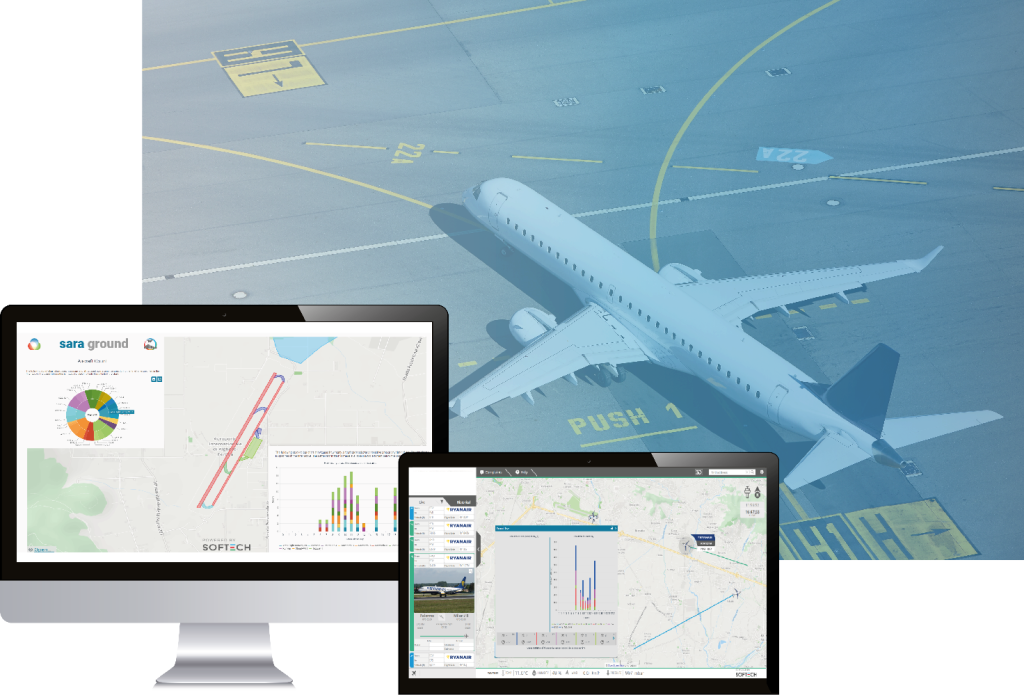SARA GROUND: brand new module for monitoring and managing the ground movements of aircraft
A new module integrated into the SARA platform which, by exploiting ADS-B technology, makes it possible to monitor and manage aircraft ground movements.

Airport environmental monitoring is a complex issue. It is usually thought that collecting data from aircraft in flight may be sufficient to have a clear picture of the impact that the airport has on the environment, but this is not entirely true. Monitoring the environment also means having a 360° view of airport activities, knowing the position and emissions of all moving vehicles, including aircraft in the taxiing and engine test phases.
For this reason, we wanted to develop a new module, integrated into the SARA platform, which makes it possible to integrate the classic monitoring with the ground movements of the aircraft.
The obtainable benefits concern many aspects:
TECHNICAL: the project is useful for the correct management and planning of investments on the infrastructure asset, with the main advantages connected to the APMS (Airport Pavement Management System).
The knowledge of the traffic data is in fact essential for the definition of the Forecast Degradation Models, used to predict the condition of the pavement over time and to assist the APMS manager in identifying the moment in which it is more appropriate to carry out a certain intervention (list priorities).
It also allows you to have useful data for air-side capacity simulations during the planning phases of interventions that include operational limitations and closures.
OPERATIONAL: the information relating to ground handling constitutes the basis of analysis for each optimization process. Stand occupancy data and the most frequent AAMM on each stand will be available. Statistics allow the definition of contingency strategies in case of sudden unavailability.
SAFETY: flight tracking data are essential for investigating serious or minor incidents that may occur inside and outside the airport grounds. In the processes of “root cause analysis”, for events of ordinary occurrence, it is strategic to have the traces on the ground of the AA.MM coming from the transponders.
ENVIRONMENTAL: The major source of noise is represented by the movement of aircraft, both in the taxiing on the ground and in the take-off and landing phases, as well as during the engine test.
By having data on the acoustic impact of ground activities and air tracks also in the neighboring areas outside the grounds, the noise monitoring activity is significantly enhanced and accurate.
Combined with a specific consultancy activity, SARA GROUND also makes it possible to evaluate the current situation of the airport and identify best practices (e.g.: management of taxi times) aimed at reducing the impact of aircraft ground movements on the total emissions of the infrastructure.
For more info and to request a demo write to: marketing@softechweb.it
Leggi le altre news
Highway Control Room: Where Mobility Takes Shape
The highway control room is the operational nerve center of motorway management — the place where information converges, strategic decisions are made, and mobility is coordinated in real time. In this environment, technology plays a critical role, enabling continuous monitoring, fast communication, and efficient traffic control. Advanced Monitoring Systems Inside the control room, operators rely […]
SARA-NOISE AT TURIN CASELLE INTERNATIONAL AIRPORT
The airport management company SAGAT SpA chooses our systems for noise monitoring and analysis. To monitor aircraft noise emissions, SAGAT Spa has chosen to rely on our SARA system. SARA is the Softech solution for monitoring and analyzing environmental parameters (noise, air quality, weather) at the airport. Equipped with highly specialized analysis software and monitoring […]
G-SMART: ADR – Aeroporti di Roma chooses our system for IoT monitoring and benchmarking of trolley collection areas.
An IoT infrastructure for the active and continuous monitoring of the trolley collection areas at Fiumicino International Airport. G-SMART is the GSE tracking system that combines different technologies (RFID, Bluetooth, ADS-B, GPS) to create the best performing solution depending on the application scenario. IPS – indoor positioning systems – are systems that allow objects to […]


